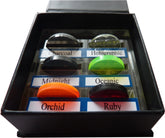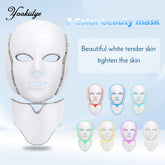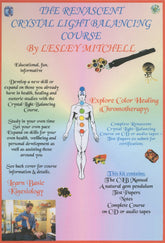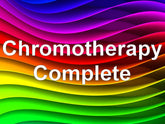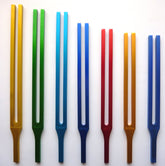Color Therapy
 Color therapy (also known as chromotherapy) is an exciting new form of healing brought forward from the Atlantean teachings, and is complimentary to such modalities as kinesiology, acupuncture and other natural healing modalities.
Color therapy (also known as chromotherapy) is an exciting new form of healing brought forward from the Atlantean teachings, and is complimentary to such modalities as kinesiology, acupuncture and other natural healing modalities. Background
Background
Chromotherapy is a therapeutic science which has been used by many races for thousands of years. The ancient Egyptians used specially built solarium rooms with different colored glasses. The sun would shine through the colored glass onto the patient to achieve specific therapeutic benefits. Others used different colored silk clothes to filter varying shades of light onto their bodies. There is also evidence of others using colored waters and colored gels to achieve the same results.
These days, many natural therapists are using chromotherapy on their patients in interesting ways. They report success in recovery of stroke victims, and in others who have chronic depression. In the United States, chromotherapy is being recognised as a complimentary system to other therapies and treatments.
One interesting announcement made by CNN recently discusses application of blue light to the backs of the knees to adjust the body clock, thus overcoming jet lag, and the problems associated with shift work. Other recent discoveries reveal the color green as a treatment system for overcoming headaches and migraines in some people.
How and why chromotherapy works
The Earth, our continents, oceans, in fact every living thing depends on light to be able to exist. Recent scientific evidence suggests that light is in fact emitted by every cell in our bodies. We live in a sea of energy where color is working within us. It shines with in our divine self, and radiates upon us from the sun. Research and observation has shown us that specific colors bring balance to our physical and emotional systems. Chromotherapy can easily be used as an alternative to Chinese acupuncture, achieving the same results in unblocking meridians without the discomfort of needles used in acupuncture.
Color Spectrum Wavelengths

![Auric Healing Color wheel]() Auric Healing Color Wheel
Auric Healing Color Wheel
Examine the Auric Healing Color wheel in the picture to the right. You can click on the wheel for a larger version of the color wheel.
Soon the pattern will begin to move and reflect with your auric colors.
Your auric color(s) may change due to many effects, including healing, negative situations, emotional states, and as we progress on our life path, we may progress through events and develop a new state of being.
Therapists: It is excellent to have your patients stare at this wheel and explain the colors to you before and after a healing. They will generally notice some differences which you may explain to them as the energies becoming more harmonious.
Let us have a look at some of the colors, and their effects on our bodies;
Green
Regulates the pituitary gland, fights depression, bulimia, and other psychosomatic conditions affecting the gastric system. It is useful in calming the nervous system, fights irritability, insomnia and can be used to assist in recovery from nervous breakdowns. Click here to read recent studies on how the color green can be used to assist in dealing with migraine headaches.
 Blue
Blue
Calming. Stimulates the parasympathetic system, reduces blood pressure and calms both breathing and heart-rate. It has anti-inflammatory and muscle relaxing effects. Fights both physical and mental tension and is used to assist in relaxation.
Red
Is used to energise and stimulate. Affects the heart by increasing pulse rate, and the muscles by increasing their tension. Influences vitality, and increases body temperature. Can be used to develop excitement and sensuality. Click here to read an interesting article on how the color red can significantly improve deteriorating eyesight, and the scientific studies that support this theorem.
Yellow
Increases neuromuscular tone. Purifies blood, helps digestion, and has a cleansing effect. Strongly stimulates happiness, brings on a sense of security, as well as a strong feeling of well-being.
White
Used for regeneration. Also, provides energy and balances the chronobiological rhythm, by stimulating the production of serotonin, a substance which regulates both sleep and the nervous system. Rebalances the psychophysical and hormonal systems in people who suffer from seasonal depression.
-
Vendor:Natures Energies
Chromotherapy Light Box
Utilizing a unique photon harmonization technique to make effective therapeutic color light for your patients ..... The Natures Energies Chromotherapy Light Box is second to no other chromotherapy light delivery system, in that it utilizes a harmonizer to adjust light to a healing wavelength safe for...- $289.00 USD
- $289.00 USD
- Unit price
- per
-
Vendor:Renascent
Chromotherapy Torch
A stunning new healing modality tool, these specially designed color tools are of the highest quality, specifically made with integrity for use by natural therapists. They come complete with batteries, a clip to attach the tool to a pocket when working, a hard case...- $199.95 USD
$225.00 USD- $199.95 USD
- Unit price
- per
-
Vendor:Renascent
Chromotherapy Torch Advanced Color Healing Discs
The advanced color discs are designed to complement the healing properties available to practitioners using the standard set of color discs which come with the chromotherapy torch. Six discs are available presented in the set. The healing properties of each disc are shown below....- $79.95 USD
$87.95 USD- $79.95 USD
- Unit price
- per
-
Vendor:Natures Energies
Color Therapy Glasses
Expose your body to the color frequency needed to bring it back into a balanced state while going about your daily tasks. Simply wear the glasses for 10-30 minutes a day (up to 60 minutes), in the color which corresponds to the results you...- From $21.95 USD
- From $21.95 USD
- Unit price
- per
-
Color Therapy Glasses - Aqua (Turquoise)
-
Color Therapy Glasses - Magenta
-
Color Therapy Glasses - Red
-
Color Therapy Glasses - Orange
-
LED Facial Beauty Mask
7 Color Light LED Facial Mask With Neck & Skin Rejuvenation Facial Care Treatment through Color Therapy On the basis of using it 20 mins daily: Assists in Activating collagen Promotes skin collagen growth, making the skin more translucent and white Tightens pores,...- $76.95 USD
$88.95 USD- $76.95 USD
- Unit price
- per
-
Vendor:Renascent
Crystal Light Balancing and Chromotherapy Workbook
Highly recommended for those requiring instruction on use of the Chromotherapy Torch. Explore the fascinating healing modality of color through this A4 work book. Understand the Chinese five elements; how they work with us and the colors they embody. Discover the energy flow to...- $24.95 USD
$29.95 USD- $24.95 USD
- Unit price
- per
-
Vendor:Renascent
eBook - Crystal Light Balancing and Chromotherapy Workbook
Highly recommended for those requiring instruction on use of the Chromotherapy Torch. Instantly available after payment has been received! Explore the fascinating healing modality of color through this downloadable eBook. Understand the Chinese five elements; how they work with us and the colors they embody....- $19.95 USD
$24.95 USD- $19.95 USD
- Unit price
- per
-
Vendor:Renascent
Crystal Light Balancing Correspondence Course
Learn the art of healing through color therapy - a natural therapy skill which will enrich your ability to align energy centres to achieve balance and well being. The course is designed for both practitioners and beginners alike. The Crystal Light Balancing Correspondence Course...- $136.95 USD
$140.00 USD- $136.95 USD
- Unit price
- per
-
Vendor:Renascent
Chromotherapy Essentials
For those seeking a basic kit consisting of the essential elements needed for learning and practising the technique of chromotherapy on the cheapest possible means possible, we have established a kit making this possible and well within your reach!Start with this kit and purchase...- $269.95 USD
$269.95 USD- $269.95 USD
- Unit price
- per
-
Vendor:Natures Energies
Chromotherapy Complete
For those seeking the complete picture and the biggest savings, we offer over 3 Kg of chromotherapy products, all bundled together into the one kit. Includes the following; Chromotherapy Torch Advanced Color Discs Chromotherapy Correspondence Course Chromotherapy Light Box Small Color Chart Large Color...- $699.95 USD
- $699.95 USD
- Unit price
- per
-
Vendor:Natures Energies
Color Therapy Information Decoder Wheel
The color therapy decoder wheel is a handy reference which provides practical information to patients and practitioners alike about color, as well as each of the colors association with the following areas; Personality Chakras Seasonal Colors Healing Properties Each of the above attributes are...- $9.95 USD
$14.95 USD- $9.95 USD
- Unit price
- per
-
Vendor:Dynamoh House
Small Color Therapy Chart
A useful reference for those interested in chromotherapy, or for the wall of the color therapist practice. Also useful as a reference tool for students. Available in 2 sizes, the charts discuss each of the colors in terms of; healing properties relationship with each...- $7.95 USD
$9.95 USD- $7.95 USD
- Unit price
- per
-
Vendor:Natures Energies
Chakra Tuning Forks with Color Therapy
Chakra Tuning Forks with Color Therapy These Chakra Tuning Forks are unique, in that they are not only sound therapy devices but they also incorporate the power of color therapy, using the same colors associated with each of the chakras. Each of the 7 forks have...- $159.95 USD
- $159.95 USD
- Unit price
- per
-
Vendor:Natures Energies
Laminated Scientific Color Therapy and Sound Therapy Wheel
Useful charts for those wishing to integrate sound therapy into their chromotherapy practice. Laminated Scientific Color Therapy and Sound Therapy Wheel 8 1/2" X 11" This beautiful Scientific Color Therapy and Sound Therapy Chart illustrates the relationships between Musical Notes Approximate Scientific Color Frequency...- $12.95 USD
- $12.95 USD
- Unit price
- per






